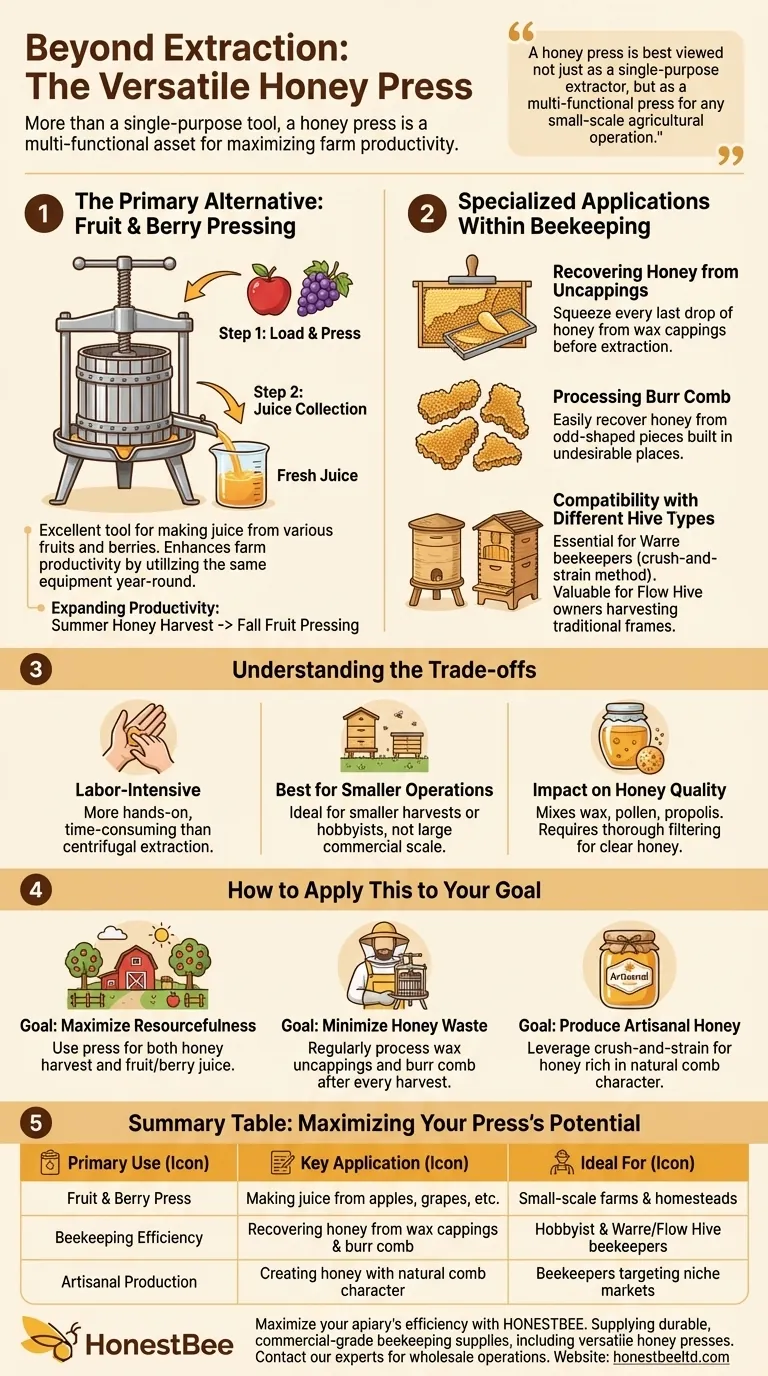Beyond honey extraction, a honey press serves as a remarkably versatile piece of farm equipment. Its primary alternative use is as a fruit press for making juice from various fruits and berries, but it also excels at specialized beekeeping tasks like processing wax uncappings and burr comb to recover every last drop of honey from your harvest.
A honey press is best viewed not just as a single-purpose extractor, but as a multi-functional press for any small-scale agricultural operation. Its ability to handle fruits, berries, and various wax-honey mixtures makes it a valuable asset for maximizing yields and diversifying farm products.

The Primary Alternative: Fruit and Berry Pressing
A honey press's fundamental design—applying mechanical pressure to separate liquid from solids—is not exclusive to honey and wax. This makes it an excellent tool for other small-batch pressing needs on a homestead or farm.
How It Works for Fruit
The process is straightforward. Just as you would load the press with honeycomb, you load it with crushed or chopped fruits or berries. Rotating the press applies pressure, squeezing the juice out, which is then collected in a container below.
Expanding Your Farm's Productivity
This dual-functionality allows you to optimize your equipment investment. The same press used for a summer honey harvest can be used again in the fall to process apples for cider or grapes for juice, enhancing overall farm productivity without purchasing additional machinery.
Specialized Applications Within Beekeeping
Even within the apiary, a press has valuable uses beyond extracting honey from standard frames. It is a tool for maximizing efficiency and minimizing waste.
Recovering Honey from Uncappings
When you uncap frames before extraction, those wax cappings are full of honey. A press is exceptionally effective at squeezing this honey out, significantly increasing your total yield from what is often considered a byproduct.
Processing Burr Comb
Bees often build irregular comb, known as burr comb, in undesirable places. A press easily handles these odd-shaped pieces, allowing you to recover the honey without difficulty.
Compatibility with Different Hive Types
The crush-and-strain method, for which a press is essential, is the standard for Warre beekeepers. It is also a valuable tool for Flow Hive owners who may have a few traditional Langstroth frames to harvest.
Understanding the Trade-offs
While versatile, a honey press is not a universal solution. Understanding its limitations is key to using it effectively.
A Labor-Intensive Process
Using a press is more hands-on and time-consuming than using a centrifugal extractor. It is a manual process that requires clamping, turning, and reloading.
Best for Smaller Operations
Due to its manual nature, a honey press is ideal for smaller honey harvests or hobbyist beekeepers. It is generally not efficient enough for large-scale commercial operations.
The Impact on Honey Quality
The "crush and strain" method inherently mixes more wax, pollen, and propolis into the honey. While some consumers value this for its natural characteristics, it requires thorough filtering to produce the clean, clear honey many expect.
How to Apply This to Your Goal
Your intended outcome should dictate how you use your press.
- If your primary focus is maximizing resourcefulness on a small farm: Use your press as a dual-purpose tool for both your honey harvest and for fruit or berry juice production.
- If your primary focus is minimizing honey waste: Regularly use the press to process all your wax uncappings and burr comb after every harvest.
- If your primary focus is producing artisanal honey: Leverage the crush-and-strain method to create a product rich in natural comb and character, catering to specific consumer preferences.
By viewing your honey press as a versatile tool for extraction, you unlock its full potential to enhance both your apiary's efficiency and your farm's productivity.
Summary Table:
| Primary Use | Key Application | Ideal For |
|---|---|---|
| Fruit & Berry Press | Making juice from apples, grapes, etc. | Small-scale farms & homesteads |
| Beekeeping Efficiency | Recovering honey from wax cappings & burr comb | Hobbyist & Warre/Flow Hive beekeepers |
| Artisanal Production | Creating honey with natural comb character | Beekeepers targeting niche markets |
Maximize your apiary's efficiency and your farm's productivity with the right equipment. HONESTBEE supplies durable, commercial-grade beekeeping supplies and equipment, including versatile honey presses, to commercial apiaries and beekeeping equipment distributors. Contact our experts today to discuss how our wholesale-focused operations can support your goals and help you get the most out of your investment.
Visual Guide

Related Products
- Electric Honey Press Machine for Squeezing Honey Comb Press Equipment
- Stainless Steel Manual Honey Press with Guard for Pressing Honey and Wax
- Stainless Steel Honey Press Wax Press with Tank
- 10L Stainless Steel Electric Honey Press Machine
- 10L Stainless Steel Honey Wax Press Extractor for Wax Cappings
People Also Ask
- Why are honey presses particularly useful for beekeepers using Top Bar hives? Maximize Your Harvest
- What are the unique characteristics of honey presses? Maximize Honey Yield for Small-Scale Beekeeping
- How does a honey press work? A Guide to Simple, High-Yield Honey Extraction
- How can the honey press be cleaned after use? A Step-by-Step Guide for Commercial Beekeepers
- How should a honey press be cleaned? A Step-by-Step Guide for Beekeepers



















